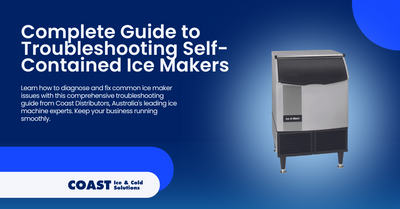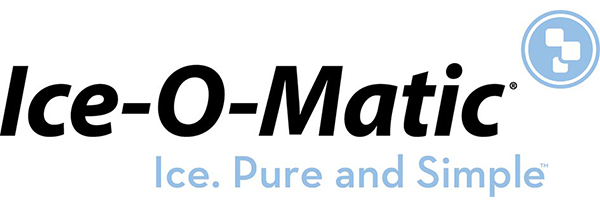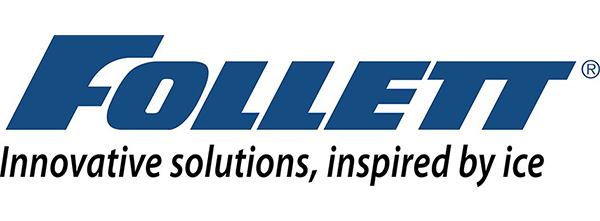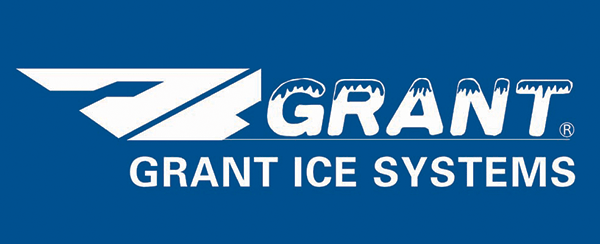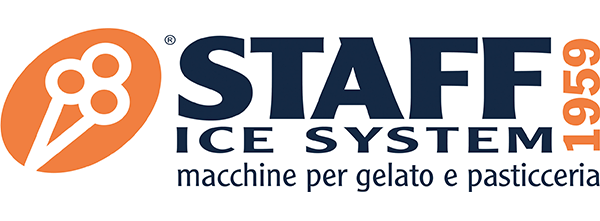The Complete Guide to Troubleshooting Self-Contained Ice Makers: Expert Solutions from Coast Distributors
The Coast Team on 29th Apr 2025
Self-contained ice makers are the unsung heroes of countless Australian businesses. From busy restaurants and lively pubs to healthcare facilities and hotels, these machines silently produce the ice necessary for daily operations. At Coast Distributors, we've seen firsthand how essential reliable ice production is for maintaining customer satisfaction and operational efficiency across diverse industries throughout Australia.
Despite their reliability, even the most robust ice machines can experience issues that disrupt their performance. The impact of a malfunctioning ice maker extends beyond mere inconvenience—it can directly affect your service quality, customer experience, and potentially your bottom line. Picture this: it's a sweltering summer day in Sydney, your venue is packed, and suddenly your ice maker stops working. This scenario is all too familiar to business owners across Australia.
Understanding common ice maker problems and their solutions is crucial for minimising downtime and maintaining seamless operations. Most issues have straightforward fixes that don't necessarily require professional intervention, though knowing when to call in the experts is equally important. This comprehensive guide aims to equip you with the knowledge to troubleshoot common ice maker problems, implement preventative maintenance strategies, and make informed decisions about your ice-making equipment.
Ice Maker Not Producing Ice
When your ice maker stops producing ice altogether, it's often the most disruptive problem you can face. Before panicking, work through these troubleshooting steps methodically to identify the cause.
First, examine your water supply connection. A secure and properly functioning water supply is fundamental to ice production. Check that the water line isn't kinked or damaged and that the water valve is fully open. Water pressure should ideally be between 140-550 kPa for most commercial ice makers. Insufficient water pressure is a common culprit behind production failures in many Australian food service establishments.
Next, inspect your water filter system. Sediment build-up in filters is particularly common in areas with hard water, such as parts of Western Australia and Queensland. A clogged filter restricts water flow to your machine, directly impacting ice production. As a rule of thumb, replace water filters every six months or more frequently if your establishment is in an area known for poor water quality.
The control board serves as the brain of your ice machine, regulating the production cycle. Signs of a malfunctioning control board include erratic operation, incomplete cycles, or no response when the machine is powered on. Control board issues typically require professional diagnosis, and Coast Distributors' service technicians are equipped with the expertise to accurately assess and repair these sophisticated components.
Temperature sensors are another critical component that can fail. If your machine isn't registering the correct temperature, it may not initiate the ice production cycle. Most commercial units should maintain a bin temperature between -1°C and 4°C for optimal performance. Use a thermometer to verify if the displayed temperature matches the actual temperature inside the unit.
Ice Maker Producing Small or Hollow Ice Cubes
Undersized or hollow ice cubes do more than just disappoint customers—they melt faster, diluting drinks and potentially affecting your business's reputation for quality. This problem typically stems from a few key issues that can be systematically addressed.
The water inlet valve is responsible for controlling water flow into the ice maker. If it's partially blocked or malfunctioning, insufficient water reaches the ice mould, resulting in small or incomplete cubes. Inspect the valve for mineral deposits, which are especially common in regions with hard water like Adelaide and Perth. Cleaning the valve with a manufacturer-approved descaling solution can often restore proper water flow.
Low water pressure can also cause this issue. Australian commercial establishments should maintain water pressure between 140-550 kPa for optimal ice production. Consider installing a water pressure gauge to monitor your system's performance, particularly if your business is located in an area with known water pressure fluctuations.
Many modern ice makers from Coast Distributors feature adjustable ice thickness settings. These settings can sometimes be inadvertently changed during cleaning or maintenance. Consult your machine's user manual to locate and adjust the ice thickness control, typically a dial or digital setting accessible on the control panel or inside the unit.
The evaporator plate's condition directly impacts ice quality. Over time, mineral scale can accumulate on this component, particularly in regions with high mineral content in the water supply. This buildup insulates the plate, reducing its cooling efficiency and resulting in incomplete ice formation. A professional cleaning with food-grade descaling solutions is recommended every 3-6 months, depending on your water quality and machine usage.
Ice Maker Making Unusual Noises
When your ice maker starts producing concerning sounds, it's rarely something to ignore. Different noises can indicate specific problems that require attention before they escalate into costly repairs.
Rattling or vibrating sounds often stem from loose components. Begin by checking that your machine is placed on a level surface—an uneven floor can cause vibration during operation. Next, inspect accessible screws and panels, tightening any that may have loosened over time. Remember that commercial kitchens experience significant temperature fluctuations that can cause components to expand and contract, gradually loosening fasteners.
Grinding or scraping noises typically indicate issues with moving parts. The most common culprits are the fan motor and condenser fan. Dust accumulation on fan blades is particularly problematic in Australian commercial kitchens due to our climate. Clean these components carefully using a soft brush or vacuum with a brush attachment, ensuring you've disconnected power before accessing internal parts.
A rhythmic knocking sound could indicate problems with the water pump or compressor. These components are central to your machine's operation and may require professional assessment. Coast Distributors' maintenance technicians can diagnose these sounds accurately, determining whether simple lubrication will suffice or if component replacement is necessary.
Humming sounds that grow louder or change pitch might indicate electrical issues. Voltage fluctuations, which can be common in older buildings or regional areas of Australia, may cause components to work harder than necessary. Consider installing a voltage stabiliser if your establishment experiences frequent power fluctuations that affect your ice maker's performance.
Ice Maker Leaking Water
Water leakage from your ice maker creates both safety hazards and potential damage to surrounding equipment and fixtures. Addressing this issue promptly is essential for workplace safety and equipment longevity.
Begin by examining all water connections. The inlet water line, drain line, and internal hoses should be inspected for signs of wear, cracks, or loose fittings. Australian food service environments often experience high ambient temperatures, particularly in commercial kitchens, which can accelerate the deterioration of rubber or plastic components. Replace any damaged water lines with food-grade alternatives that meet Australian standards.
Drain blockages are a common source of water leakage. Food particles, mineral buildup, and even mould can obstruct proper drainage, causing water to back up and overflow. Regular cleaning of the drain system with approved sanitising solutions prevents these blockages. In areas with high humidity, such as tropical North Queensland, more frequent drain maintenance may be necessary to prevent mould growth.
Check that your ice maker is perfectly level using a spirit level. Even slight tilting can cause water distribution problems during the ice-making cycle, leading to overflow or leakage. Adjustable feet on most commercial ice makers from Coast Distributors allow for precise levelling, even on slightly uneven surfaces.
The water level control mechanism determines how much water enters the ice-making system. If this component malfunctions, it may allow too much water into the unit, resulting in overflow. Professional calibration of this system ensures optimal water levels for your specific model and installation environment.
Ice Maker Freezing Up
When components of your ice maker freeze up, the machine's efficiency drops dramatically, and complete failure may follow if the issue isn't addressed.
Temperature settings are the first element to check. Most commercial ice makers operate optimally when the ambient room temperature is between 10°C and 32°C. During Australia's extreme summer temperatures, air-conditioning failures can lead to overheated environments that cause ice makers to work harder and potentially freeze up. Verify that your thermostat is functioning correctly and set appropriately for your model.
Condenser coils require regular cleaning to maintain proper heat exchange. These coils release heat generated during the ice-making process, and when clogged with dust and debris, they can't function efficiently. In dusty Australian environments, particularly in rural or coastal areas, more frequent cleaning may be necessary. Use a coil brush or vacuum attachment designed for this purpose, being careful not to damage the delicate fins.
Inspect the door gaskets and seals for proper function. Deteriorated seals allow warm, humid air to enter the unit, creating condensation that can freeze on critical components. The harsh Australian sun can accelerate the degradation of rubber seals, particularly in units placed near windows or in outdoor areas. Replace any cracked or compressed gaskets to maintain the sealed environment your ice maker requires.
The defrost cycle timing may need adjustment, especially if your machine is installed in an environment different from what the factory settings anticipated. High-humidity environments like coastal areas of Queensland and New South Wales may require more frequent defrost cycles than the standard settings allow. Consult your machine's manual or contact Coast Distributors' technical support for guidance on adjusting these settings for your specific conditions.
Preventative Maintenance for Ice Makers
Proactive maintenance significantly extends the lifespan of your ice maker while reducing unexpected breakdowns. Implementing a structured maintenance schedule is one of the wisest investments you can make for your business.
Establish a regular cleaning routine tailored to your usage patterns and local water conditions. Generally, ice makers in Australian commercial settings benefit from bi-weekly external cleaning and monthly internal sanitising. Areas with hard water may require more frequent attention to prevent mineral buildup on critical components.
Descaling should be performed quarterly or more frequently if you notice signs of scale accumulation. Use only food-grade descaling solutions that comply with Australian food safety regulations. Homemade solutions like vinegar may seem cost-effective but can damage components and void warranties.
Water filtration systems are your first line of defence against contaminants that can damage your ice maker. Replace filters according to manufacturer recommendations or sooner if you notice decreased water flow or ice quality. Coast Distributors' water filter systems are specifically designed to enhance ice quality while extending the performance and lifespan of your ice machine. In fact, the warranty on many ice machines may be voided if no water filter system is fitted, making this a crucial investment for any commercial setup.
Consider scheduling professional service visits bi-annually. Coast Distributors' certified technicians can perform comprehensive maintenance that goes beyond surface cleaning, including refrigerant level checks, electrical system testing, and mechanical adjustments that require specialised tools and expertise.
When to Replace vs. Repair Your Ice Maker
Knowing when to invest in repairs versus replacement can save significant costs over time. Several factors should influence this decision.
Age is a primary consideration. Most commercial ice makers have an expected service life of 7-10 years. If your unit is approaching this age and experiencing frequent issues, replacement may be more economical than ongoing repairs. New models from Coast Distributors offer improved energy efficiency that can offset the initial investment through reduced operating costs.
Calculate the cost of repairs against the current value of your machine. As a general rule, if a repair exceeds 50% of the replacement cost for a machine over five years old, replacement deserves serious consideration. Factor in potential future repairs when making this assessment.
Energy efficiency improvements in newer models can be substantial. Modern ice makers from Coast Distributors' range use up to 40% less energy and 25% less water than models manufactured just a decade ago. For busy Australian establishments, these savings can significantly impact operational costs, particularly during the summer months when ice machines work hardest.
Production capacity should match your current needs. If your business has grown since purchasing your original ice maker, upgrading to a higher-capacity model may be necessary regardless of your existing unit's condition. Conversely, if your requirements have decreased, a smaller, more efficient unit might better serve your needs.
Choosing the Right Ice Maker for Your Business
Selecting the appropriate ice maker involves understanding both your specific needs and the various options available in the Australian market.
Consider the type of ice required for your business applications. Flake ice is ideal for seafood displays and healthcare uses, while cube ice is preferred for beverage service. Nugget ice, increasingly popular in Australian bars and cafés, offers a chewable texture that enhances beverage experiences. Coast Distributors offers machines specialising in each ice type, with models designed specifically for Australian commercial environments.
For establishments with limited space but requiring premium ice quality, the Ice-O-Matic UCG series self-contained gourmet ice makers offer an excellent solution. These undercounter units produce crystal-clear conical ice that melts slowly, perfect for bars, clubs, restaurants, and cafés. With production capacities ranging from 20.5kg to 69kg of ice per day, these space-efficient machines are easy to install, service, and maintain. They come with a generous 2-year parts and labour warranty, ensuring peace of mind for your business investment.
For businesses with higher volume requirements, the Ice-O-Matic ICE series cube ice makers deliver production capacities starting from 96kg per day. Constructed from sturdy, corrosion-proof stainless steel, these machines feature proven classic cube shapes in full or half sizes, making them ideal for a wide range of hospitality applications. These premium units are backed by an industry-leading 3-year parts and labour warranty, with 5 years of coverage on the evaporator and compressor.
For industrial-scale needs or specialised applications like seafood displays or healthcare facilities, the Grant Sub Zero Flake Ice Machines provide exceptional performance with production capacities up to 600kg of ice per day. These reliable workhorses come with a comprehensive 3-year parts and labour warranty on the complete system, plus an extended 5-year warranty on the evaporator, demonstrating Coast Distributors' confidence in their durability.
Water quality in your region should influence your selection. Areas with problematic water may benefit from models with advanced filtration systems or those specifically designed to operate in challenging water conditions. Coast Distributors can recommend appropriate filtration solutions based on your local water profile.
Energy and water efficiency ratings have become increasingly important considerations for Australian businesses facing rising utility costs. Look for models with high WELS (Water Efficiency Labelling and Standards) ratings and energy-efficient features that can reduce operational costs over the equipment's lifespan.
Warranty Protection and Service Support
Protecting your investment with appropriate warranty coverage is essential for business continuity and financial security. Coast Distributors offers comprehensive warranty protection across their entire range of ice making equipment, with terms tailored to each product line.
For Ice-O-Matic self-contained gourmet ice makers, a 2-year parts and labour warranty provides excellent coverage for these workhorse undercounter units. The premium Ice-O-Matic cube ice makers benefit from an extended 3-year parts and labour warranty, plus an impressive 5-year warranty on both the evaporator and compressor—the most critical and costly components in any ice machine.
It's important to note that proper installation and maintenance are key factors in maintaining warranty validity. Coast Distributors strongly recommends installing a quality water filtration system with every ice machine purchase, as failing to do so may actually void the warranty on your equipment. This requirement reflects the significant impact that water quality has on ice machine performance and longevity.
To maximise the protection offered by your warranty, be sure to register your warranty promptly after purchase. This simple step ensures that your warranty period is accurately recorded and streamlines any future service requests. Should you ever require warranty service, Coast Distributors makes the process straightforward with their convenient online service request form, allowing you to quickly arrange for expert assistance.
For complete details on warranty coverage and terms for your specific ice machine model, visit the Warranty Terms page on the Coast Distributors website. Understanding these provisions before making your purchase helps ensure you select equipment with protection that aligns with your business needs and risk management strategy.
Conclusion
Maintaining your ice maker's performance is essential for business continuity and customer satisfaction. Most common issues can be resolved through systematic troubleshooting and regular maintenance, while knowing when to seek professional assistance prevents minor problems from escalating into major failures.
Coast Distributors stands as Australia's leading authority on commercial ice making equipment, offering not only premium machines suited to our unique climate and conditions but also the expertise to keep them running at peak performance. Our comprehensive range includes solutions for businesses of all sizes, from compact café operations to large hospitality venues and industrial applications.
Remember that preventative maintenance is always more cost-effective than emergency repairs. By implementing the strategies outlined in this guide and partnering with Coast Distributors for your equipment and service needs, you can ensure reliable ice production that supports your business operations year-round.
For personalised advice on troubleshooting, maintenance, or selecting the perfect ice maker for your Australian business, contact Coast Distributors' expert team. With over 80 years of industry experience and 24-hour service and technical support, we're committed to providing solutions that enhance your operations and contribute to your business success. For urgent assistance, you can reach us directly at (02) 9524 1234 or submit a service request online.

